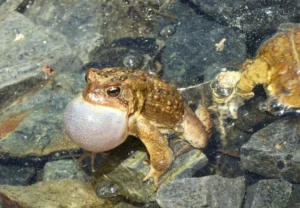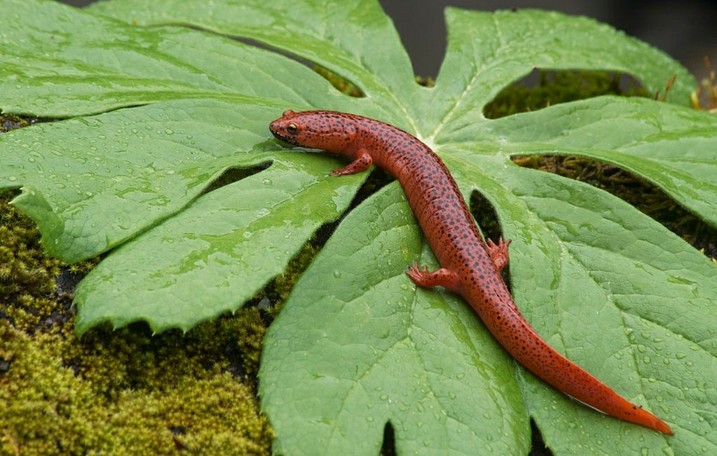If you’re wondering whether salamanders make sounds, the direct answer is this:
Salamanders are mostly very quiet animals. They don’t croak or call like frogs. Some species can make very soft, faint sounds when they feel stressed, scared, or bothered, but these noises are rare and not used for real communication.
Instead, salamanders rely mostly on silent methods to “talk” to each other, using smells, body movements, and touch.
How Are Salamanders Different From Frogs?
A big reason salamanders don’t make loud sounds like frogs is because of their body structure.
Frogs have special vocal sacs in their throats. These sacs work like tiny balloons that fill with air to make croaks and calls much louder.

When frogs want to call, they push air into these sacs and create their famous croaking sounds.
Salamanders, on the other hand, don’t have vocal sacs. Their throats and mouths are built differently and aren’t made for producing loud noises.
This means salamanders can’t croak or call like frogs. While some salamanders can make soft sounds, their body shape limits how much noise they can produce.
What Sounds Do Salamanders Make?
Even though salamanders are usually quiet, some species have been heard making very soft sounds.
These are faint and often hard to hear unless you are very close.
Clicking and Popping
One type of soft noise salamanders make is clicking or popping sounds. These have been recorded mainly when researchers handle salamanders like the red-backed salamander.
These small clicks sound a bit like knuckles cracking. The salamander isn’t trying to send a message; these sounds happen naturally when they move or when their skin or joints shift.
Rasping and Squeaking
Some larger salamanders, like tiger salamanders, sometimes make soft rasping or squeaking noises when they feel threatened or uncomfortable.
These sounds are quick and quiet, more like automatic responses to stress than true communication.
Mostly Silent
The main point to remember is that salamanders rarely use sounds to communicate. They are mostly silent creatures that rely on other ways to “talk.”
How Do Salamanders Really Communicate?
Since salamanders don’t talk with sounds, how do they share information? They’ve developed other clever methods that fit their quiet, hidden lifestyle.
Chemical Signals
The biggest way salamanders communicate is through chemical signals called pheromones. These are invisible messages sent through smells that other salamanders can detect.
Salamanders have a very strong sense of smell and can pick up on these chemical messages to learn important things.
Chemical signals can tell a salamander if another is male or female, if it’s ready to mate, or even if it’s from the same family group. This silent, invisible language helps salamanders find mates and avoid strangers.
Body Language and Movement
Salamanders use their bodies to send messages too. Tail waving, body postures, or certain movements can show how they feel or what they want.
For example, a male might wave his tail in a special way to get a female’s attention during courtship. Or a salamander might arch its back and puff up to look bigger and scare off threats.
These physical cues are important since salamanders don’t rely on loud sounds.
Touch and Contact
Physical contact is another part of salamander communication. They might nudge each other gently with their heads or tails.
This can be part of mating rituals or a way to recognize each other. Touch helps salamanders stay connected, especially when they live close together.
How Do Salamanders Find Mates?
Unlike frogs that call loudly to attract mates, salamanders use quiet, subtle methods.
No Mating Calls
Male salamanders don’t croak or call. Their bodies don’t allow them to make those sounds. Instead, they depend on other ways to catch a female’s attention.
Chemical Attraction
One main method is through pheromones; special chemicals released by males to signal they are nearby and ready to mate. Females can smell these signals and decide whether to respond.
Courtship Movements
Males also perform courtship dances or movements, like waving their tails or gently nudging females.
These motions, combined with chemical signals, help females choose mates. The whole process is quiet but effective.
Why Are Salamanders So Quiet?
There are good reasons salamanders evolved to be quiet animals.
Their Environment
Many salamanders live in places where sound doesn’t carry well. They hide under logs, rocks, and thick leaf litter. In these cramped, damp spaces, chemical signals and touch work better than sounds that would fade quickly.
Salamanders also live in noisy forests where birds, insects, and other animals create constant background noise. In such an environment, quiet chemical signals are more reliable than calls that could get lost.
Avoiding Predators
Staying quiet helps salamanders avoid being found by predators. Many predators use sound to locate prey, so salamanders keep silent to stay safe.
Making loud noises would make salamanders easier targets. Their quiet nature gives them a better chance to hide and survive.
Saving Energy
Making sounds takes energy, and salamanders are cold-blooded animals that must conserve energy carefully. Silent communication through smells and movements uses less energy than calling loudly.
Common Myths About Salamanders and Sounds
People often misunderstand salamanders and their communication.
- Myth: Salamanders never make sounds.
Reality: Some do make soft, rare sounds, but it’s not their main way to communicate. - Myth: Salamanders call to attract mates like frogs.
Reality: Salamanders don’t make mating calls. They use chemical signals and movements. - Myth: Salamanders can’t hear.
Reality: They can hear, but sounds aren’t their main communication tool.
Why Study Salamander Communication?
Studying how salamanders communicate helps us understand their behavior and protect them.
Knowing how salamanders find mates, avoid danger, and interact helps scientists learn about their lives and needs.
Many salamanders face threats from habitat loss and pollution. Understanding their communication can help create better protection plans.
Because salamanders don’t call, scientists use other methods to study them; like watching behavior closely or checking chemical signals in their habitats.
Changing climates may affect salamanders’ ability to communicate and survive. Research helps predict and manage these impacts.
Conclusion
Salamanders live in a quiet, hidden world. They don’t make loud sounds like frogs but use chemical signals, body movements, and touch to communicate.
This silent language fits their lifestyle and helps them find mates, avoid predators, and survive.
So, the next time you spot a salamander, remember; it may not croak or call, but it’s still having important conversations.
These quiet signals are part of what makes salamanders fascinating and well-adapted to their environment.

